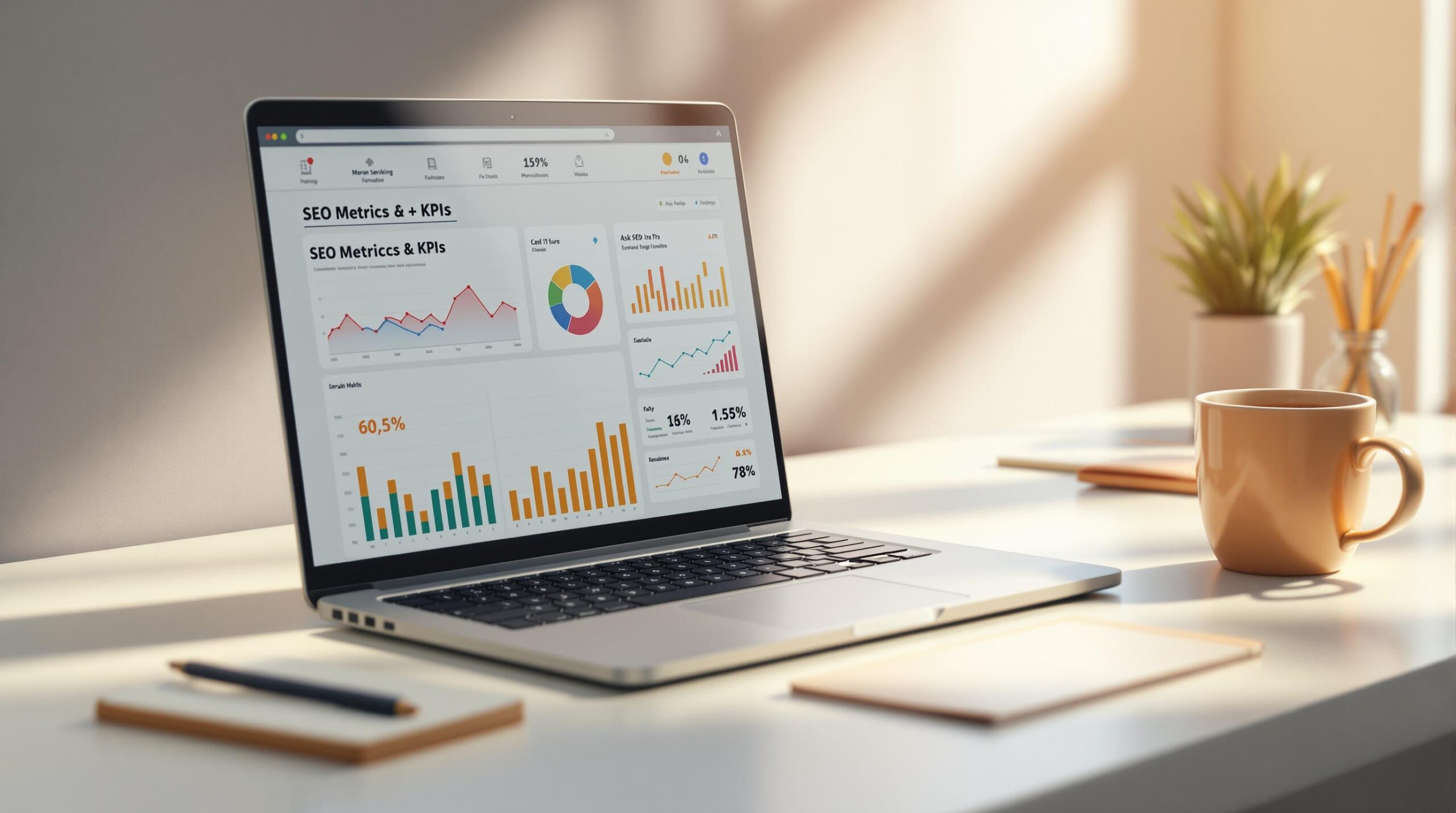SEO metrics track specific data points like page speed, bounce rates, or backlinks to measure how your website is performing. SEO KPIs, on the other hand, focus on progress toward business goals, such as organic traffic growth, conversions, or revenue from search.
Quick Overview:
- SEO Metrics: Tactical, short-term, detailed performance data.
- SEO KPIs: Strategic, long-term, tied to business results.
Quick Comparison:
| Aspect | SEO Metrics | SEO KPIs |
|---|---|---|
| Purpose | Tracks performance | Measures goal progress |
| Focus | Tactical data points | Strategic outcomes |
| Scope | Broad performance data | Key business indicators |
| Impact | Guides daily actions | Shapes overall strategy |
| Time Sensitivity | Short-term or real-time | Long-term and goal-focused |
Key takeaway: Use metrics for daily adjustments and KPIs to ensure your SEO efforts align with your business goals. Both are essential for success.
Main Differences: Metrics vs. KPIs
Purpose and Scale
Metrics provide detailed insights into specific performance areas, while KPIs are tied to overarching business goals. This difference determines how organizations evaluate and act on SEO data.
Here’s a quick comparison to clarify:
| Aspect | Metrics | KPIs |
|---|---|---|
| Focus | Specific performance data | Broader business objectives |
| Scope | Detailed measurements | High-level goal tracking |
| Time sensitivity | Short-term or real-time | Long-term and goal-focused |
| Business alignment | Operational insights | Strategic alignment |
| Decision level | Day-to-day adjustments | Strategic planning |
Decision Impact
Metrics and KPIs play distinct roles in decision-making. Metrics help with immediate tasks like optimizing technical elements or tweaking content. KPIs, on the other hand, guide larger decisions, such as resource allocation and long-term strategies. SearchX emphasizes that combining both is key to effective SEO: metrics handle quick fixes, while KPIs ensure those fixes align with broader goals.
Measurement Periods
Metrics are best monitored daily or weekly to enable quick responses. KPIs, however, should be reviewed monthly or quarterly to evaluate progress toward strategic objectives. By analyzing both together, you can confirm that improvements in specific metrics contribute to achieving your KPIs. This approach ensures your SEO efforts remain both tactical and goal-oriented.
The Difference Between Measures, Metrics, and KPIs
SEO Metrics and KPIs in Practice
Practical measurement connects daily SEO efforts to broader goals, ensuring every action contributes to meaningful results.
Key SEO Metrics
Here are some important metrics to track regularly:
| Metric Category | Key Metrics | What They Measure |
|---|---|---|
| Technical SEO | Page Speed, Core Web Vitals, Mobile-friendliness | Website performance and user experience |
| Content Performance | Click-through Rate (CTR), Time on Page, Bounce Rate | User engagement and content relevance |
| Backlink Quality | Domain Authority, Referring Domains, Backlink Growth | Strength of your link profile |
| Crawling & Indexing | Crawl Rate, Index Coverage, Site Errors | Technical health of your site |
| SERP Performance | Average Position, Featured Snippets, Rich Results | Visibility in search results |
Key SEO KPIs
- Organic Traffic Growth: Tracks the increase in visitors arriving via search engines.
- Conversion Rate from Organic Search: Measures how effectively organic traffic turns into desired actions, like purchases or sign-ups.
- Revenue Attribution: Monitors the direct financial impact of organic search efforts.
These KPIs work together with metrics to provide a clear picture of SEO success.
Linking Metrics to KPIs
Aligning metrics with KPIs is crucial. For example, improving page speed can lead to better conversion rates, while a higher CTR can increase organic traffic.
"We deliver real, measurable results that impact on your bottom line. SearchX isn’t just an SEO provider – we’re an extension of your team, focused on accelerating your growth." – SearchX
The table below highlights how specific metrics influence key KPIs:
| Metric | Related KPI | Impact |
|---|---|---|
| Page Speed | Conversion Rate | Faster websites tend to convert more visitors |
| CTR | Organic Traffic | Higher CTRs result in more visitors |
| Backlink Quality | Domain Authority | A strong link profile boosts rankings |
| Content Engagement | Revenue | Engaged users are more likely to take action |
SearchX’s dashboard provides real-time insights, showing how metric improvements directly support KPI achievements [3].
sbb-itb-880d5b6
Choosing Effective Measurements
Match Goals to Measurements
Your metrics and KPIs should directly align with your business objectives. Each goal requires specific methods to measure success.
| Business Goal | Primary KPIs | Supporting Metrics |
|---|---|---|
| E-commerce Sales | Revenue from Organic Search | Product Page CTR, Cart Abandonment Rate |
| Lead Generation | Qualified Lead Volume | Form Completion Rate, Time to Contact |
| Brand Awareness | Branded Search Volume | SERP Visibility, Share of Voice |
| Content Marketing | Organic Traffic Value | Time on Page, Content Engagement |
The choice of metrics also depends heavily on your business model.
Business Model Factors
For B2B companies, focus on the quality of leads, track long conversion cycles, and measure engagement with high-value content. E-commerce businesses should prioritize revenue-related metrics and product performance. Service-oriented businesses, on the other hand, should emphasize local SEO indicators like phone calls and form submissions.
Short-term vs. Long-term Tracking
It’s important to balance immediate results with broader, long-term goals.
- Short-term metrics: These include keyword rankings, organic traffic, conversion rates, and bounce rates. They help you track quick wins and day-to-day progress.
- Long-term KPIs: Metrics like backlink growth, domain authority, and branded search volume reflect overall growth and strategic success over time.
Measurement and Reporting Methods
SEO Tracking Tools
In today’s SEO landscape, having the right tools is crucial for monitoring metrics and KPIs. Google Search Console offers essential insights into how your site performs in search results, while Google Analytics 4 provides detailed data on user behavior and conversions.
Specialized SEO tools focus on specific areas:
| Tool Category | Primary Purpose | Features |
|---|---|---|
| Rank Tracking | Monitor SERP Positions | Keyword rankings, SERP features, competitor analysis |
| Technical SEO | Analyze Site Health | Crawl reports, site speed checks, mobile optimization |
| Content Performance | Measure User Engagement | Time on page, scroll depth, content gap analysis |
| Backlink Analysis | Assess Link Profiles | Domain authority, toxic link detection, outreach opportunities |
These tools deliver the insights you need to create clear, actionable reports.
Report Creation Guide
To create SEO reports that resonate, focus on connecting metrics to business goals. A well-structured report should include:
- Executive Summary: Summarize key KPIs and highlight major changes, using comparisons over time to show progress.
- Performance Dashboard: Use visuals to present key metrics. For example, if your goal is lead generation, show how organic traffic growth aligns with conversion rates.
- Action Items: Provide a clear list of data-backed recommendations and next steps.
This approach ensures your reports clearly communicate progress and opportunities.
Data-Based Improvements
Turning data into action is where the real impact happens. Here’s how to use insights to improve your SEO strategy:
- Regular Audits: Perform monthly technical audits to catch and resolve potential issues early.
- Content Optimization: Analyze engagement metrics to refine your content. For example, a high bounce rate might mean your content isn’t meeting search intent.
- Strategic Adjustments: Reallocate resources based on performance data. If certain content types drive better results, focus more effort there.
For example, SearchX uses real-time dashboards to give clients full visibility into performance, enabling quick adjustments based on up-to-date metrics. This approach helps businesses stay agile while keeping both short-term and long-term goals in focus.
Conclusion: Key Takeaways
Understanding the difference between SEO metrics and KPIs is crucial for achieving measurable success. Metrics offer detailed data points, while KPIs tie directly to business goals, helping you focus on outcomes that truly matter.
| Component | Purpose | Impact |
|---|---|---|
| Strategic Alignment | Align metrics and KPIs with goals | Keeps efforts focused and efficient |
| Data-Driven Decisions | Leverage real-time insights | Supports quick, informed adjustments |
| Outcome Focus | Track revenue and growth impact | Shows clear ROI |
These elements connect your day-to-day SEO tasks to broader business objectives. By producing quality content, earning strong backlinks, and refining technical SEO, you can boost visibility and attract traffic that converts into revenue.
Bringing together technical know-how and business strategy is the foundation of long-term SEO success, turning data into real growth.
"You’re not paying for a checklist of tasks; you’re paying for outcomes. We’re relentless in our pursuit of success and adjust strategies based on what’s getting you results – whether that’s new tactics, shifting focus, or doubling down on winning strategies." – SearchX




